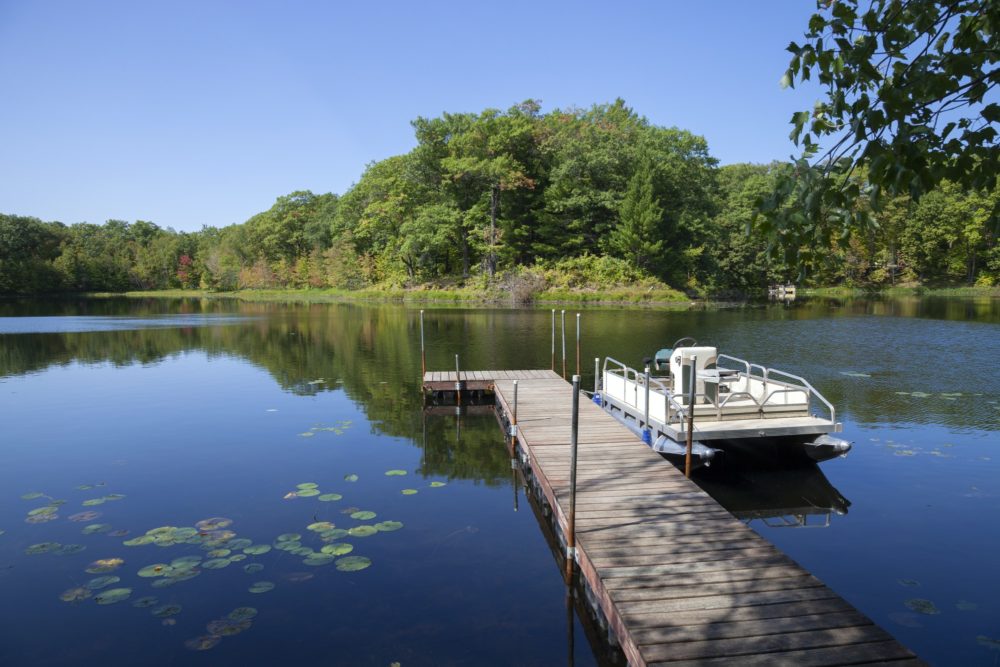A pontoon boat is a flat-bottomed vessel with pontoons or tubes on the bottom providing buoyancy, allowing it to cruise in both deep and shallow waters. Knowing how shallow a pontoon boat can go is important because it can reduce the risk of running aground and causing underwater damage. The average shallow depth for a pontoon boat is around 1 to 2 feet, though it can vary depending on the size and weight of the boat, as well as the water conditions. Some smaller pontoon boats can even operate in water as shallow as a few inches.
However, it’s important to note that the depth at which a pontoon boat can safely operate will depend on factors such as the weight distribution of the boat and the type of bottom it’s operating over, so it’s always important to exercise caution and be aware of the water depth and conditions when operating any watercraft.
Factors Affecting How shallow a Pontoon Boat can go
Draft
The draft of a pontoon boat is a crucial factor in determining how shallow the boat can safely navigate. Draft refers to the depth of the boat’s hull below the waterline. A pontoon boat with a shallow draft can navigate shallow waters without running aground. Shallow-draft boats are designed to skim over the water’s surface rather than plow through it.
The shallow draft of a pontoon boat also makes it easier to access shallow coves and inlets, providing more opportunities for fishing, swimming, and exploring. When looking for a pontoon boat, it’s essential to consider the draft and ensure it aligns with your navigational needs.
Weight
The weight of a pontoon boat is another critical factor that can affect its ability to navigate shallow waters. A heavier boat will sit lower in the water, increasing the draft and making it more challenging to navigate in shallow areas. The weight of the boat includes not only the weight of the hull but also the weight of all the equipment, furniture, and passengers.
To increase the boat’s ability to navigate shallow waters, you may consider removing unnecessary items and reducing the number of passengers. Choosing a pontoon boat made from lightweight materials can also help keep the weight down and improve its ability to navigate in shallow waters.
Hull design
The design of the hull can play a significant role in how shallow a pontoon boat can go. The design of the hull impacts not only the boat’s draft but also its maneuverability, stability, and speed. A hull that is designed to be more streamlined and shallow will be better suited for navigating shallow waters. Some pontoon boats have a tri-toon design, which includes three pontoons instead of two.
The extra pontoon increases the boat’s stability and provides a shallower draft, making it easier to navigate shallow waters. When looking for a pontoon boat, consider the design of the hull and how it aligns with your intended use.
Water conditions
While the depth of the water is an essential factor to consider when navigating shallow waters, it is not the only factor. The condition of the water, such as the presence of rocks, sandbars, or other obstacles, can also impact the boat’s ability to navigate.
A boat with a shallow draft can still run aground if the water conditions are not favorable. It’s essential to navigate at slower speeds in shallow water and keep an eye out for any potential hazards. Be sure to familiarize yourself with the water conditions in the area before setting out on your pontoon boat adventure.
Propulsion
The type of propulsion system on a pontoon boat can impact its ability to navigate shallow waters. For example, a boat with an outboard motor may be better suited for shallow-water navigation than a boat with an inboard motor.
Outboard motors are designed to tilt and raise out of the water, providing a shallower draft and making it easier to navigate shallow waters. Inboard motors are typically fixed in place and can be more challenging to navigate in shallow areas. When selecting a pontoon boat, consider the type of propulsion system and how it aligns with your navigational needs.

How to Determine the Minimum Depth for Your Pontoon Boat
Determining the minimum depth for your pontoon boat is vital for safe and successful shallow-water boating. Here is a step-by-step guide to help you determine the minimum depth for your pontoon boat.
• Check the size and weight of your pontoon boat. The larger and heavier your boat is, the deeper the draft. Generally, pontoon boats range from a minimum draft of 10 inches on a smaller boat to 12 inches on a larger vessel.
• Check the weight and load of your pontoon boat. A light load will cause the boat to sit higher in the water, resulting in a shallower draft. A heavily loaded boat will sit lower in the water, resulting in a deeper draft.
• Set your depth alarm accordingly. Pontoon boats often come with depth alarms, which can be set to double the minimum draft of your boat. For example, if your boat has a minimum draft of 10 inches, set the depth alarm to 7 feet.
• Pay attention to local knowledge about the water body you are boating in. Knowing the area can help you prepare for shallow water areas.
• Carry a “poke pole” or “depth stick” in your boat. This can be used to gauge the depth of the shallow water and determine if your boat can safely pass through without getting stuck.
For example, if your pontoon boat is a smaller vessel with a 10-inch minimum draft, you should set your depth alarm to 7 feet and carry a depth stick to help you determine if your boat can safely pass through shallow water areas.

Tips for Operating a Pontoon Boat in Shallow Water
Navigating a pontoon boat in shallow water can be an exciting experience, but it also requires caution and proper technique to ensure safety. Here are some tips for operating a pontoon boat in shallow water:
Slow down: Reducing your speed is essential when navigating shallow water. It gives you more time to react to obstacles and reduces the risk of running aground. Slower speeds also create less turbulence, preventing waterway ecosystem damage.
Watch for hazards: Always watch for potential hazards such as rocks, sandbars, and other obstacles lurking just beneath the surface. These hazards can be challenging to spot, so it’s essential to navigate slowly and steadily and look for changes in the water’s color or texture.
Know your draft: Understanding the draft of your pontoon boat is critical when navigating shallow waters. The draft refers to the depth of the boat’s hull below the waterline. A shallow-draft boat can navigate shallow waters more easily than a boat with a deeper draft. Familiarize yourself with your boat’s draft and the water depth in the area you plan to navigate.
Use your trim: If your pontoon boat has a trim system, it can be beneficial to use it when navigating shallow water. Adjusting the trim can help raise the boat’s bow and reduce the draft, allowing you to navigate shallower waters safely.
Be mindful of your propeller: The propeller on your pontoon boat can be easily damaged by hitting rocks, sandbars, or other obstacles in shallow water. To avoid damage, be cautious when approaching shallow areas, and consider raising the engine or using a trolling motor to navigate.
Stay on marked channels: When navigating in unfamiliar waters, stay on marked channels and avoid going off course. These channels are marked for a reason, indicating the safest route to navigate in shallow water.
FAQs
What size of Pontoon Boat is best for shallow waters?
A pontoon boat with a shallow draft, typically around 10 to 12 inches, is the best choice for shallow-water navigation. A shallow draft allows the boat to navigate in shallower waters without hitting the bottom or running aground. Additionally, pontoon boats with flat-bottomed designs tend to be more suitable for shallow-water navigation as they can easily glide over shallow areas.
How can you tell if the water depth is safe for your Pontoon Boat before entering?
To ensure the safety of your pontoon boat and prevent getting stranded or damaging your boat, it’s essential to determine the water depth before entering it. You can use several methods to determine if the water depth is safe for your pontoon boat, including using a depth finder, checking nautical charts, and looking for signs or markers that indicate the water depth or warn of shallow areas. A depth finder is a device that uses sonar technology to measure the depth of the water in real time, allowing you to determine if it’s safe to navigate.
Nautical charts are maps that show the water depth and other important navigational information. You can use them to plan your route and determine if the water depth is safe for your pontoon boat. In some areas, signs or markers may indicate the water depth or warn of shallow areas, which can help you make informed decisions about where to navigate your pontoon boat. By taking these precautions, you can enjoy a safe and enjoyable boating experience.
Can you use a trolling motor on a pontoon boat to help it move through shallow water?
You can use a trolling motor on a pontoon boat to help it move through shallow water. The trolling motor will provide enough power to get the boat through the shallows without trouble. Remember that when using a trolling motor, you’ll need to adjust the trim of the outboard engine to achieve the desired depth.
Make sure to choose a trolling motor compatible with your pontoon boat. You don’t want to overload your boat with too much weight, so be sure to select an appropriate motor for your vessel. With the right equipment, you should easily navigate even the shallowest waters.
What type of engine should be used on a Pontoon Boat?
When it comes to choosing the best motor for a pontoon boat, the most common choice is an outboard motor. Outboard motors are a tried-and-true option, and they offer a variety of benefits. Newer outboard motors are very quiet and pleasant, while older ones are much louder. Pontoon outboard engines are louder than inboard engines, but the difference isn’t massive. Outboard motors also don’t take up as much deck space, so you won’t lose out on your available floor area.
Inboard motors offer more power and an open transom, which is ideal for tow sports but is not as popular for pontoon boats. Inboard motors can also encroach on your boat’s deck space, so you’ll need to consider if the added power is worth the decrease in floor area.
How much weight can a Pontoon Boat hold?
The weight capacity of a pontoon boat will depend on its size and construction materials. Generally, small pontoon boats that measure up to 20 feet can hold up to 2,500 pounds, while larger boats can hold up to 5,000 pounds or more. Pontoon boats are designed to be lightweight and easy to navigate in all types of water, making them ideal for carrying heavier loads. The draft of a pontoon boat also affects how much weight it can carry. With a full prop in the water, the draft can range from 16 to 24 inches, depending on the size of the boat, while the draft is much shallower (10 to 12 inches) when the prop is out of the water.
Is it possible for a pontoon boat to get stranded if it goes too far into shallow water?
Yes, it’s possible for a pontoon boat to get stranded if it goes too far into shallow water. The depth of the water is a critical factor in pontoon boat navigation, and if the boat’s draft exceeds the water’s depth, it can become stuck or even damaged.
If a pontoon boat ventures too far into shallow water, its pontoons can make contact with the bottom, which can cause the boat to become stuck or “grounded.” This can cause damage to the boat’s hull, propellers, or other components. Additionally, if the boat is heavily loaded or has a high speed, the impact can be even more significant, causing more damage to the boat or the surrounding environment.

